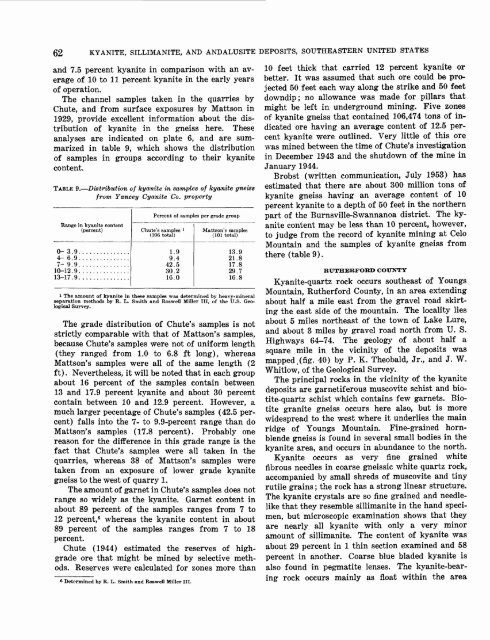Kyanite, Sillimanite, and Andalusite Deposits of the Southeastern ...
Kyanite, Sillimanite, and Andalusite Deposits of the Southeastern ...
Kyanite, Sillimanite, and Andalusite Deposits of the Southeastern ...
Create successful ePaper yourself
Turn your PDF publications into a flip-book with our unique Google optimized e-Paper software.
62<br />
KYANITE, SILLIMANITE, AND ANDALUSITE DEPOSITS, SOUTHEASTERN UNITED STATES<br />
<strong>and</strong> 7.5 percent kyanite in comparison with an average<br />
<strong>of</strong> 10 to 11 percent kyanite in <strong>the</strong> early years<br />
<strong>of</strong> operation.<br />
The channel samples taken in <strong>the</strong> quarries by<br />
Chute, <strong>and</strong> from surface exposures by Mattson in<br />
1929, provide excellent information about <strong>the</strong> distribution<br />
<strong>of</strong> kyanite in <strong>the</strong> gneiss here. These<br />
analyses are indicated on plate 6, <strong>and</strong> are summarized<br />
in table 9, which shows <strong>the</strong> distribution<br />
<strong>of</strong> samples in groups according to <strong>the</strong>ir kyanite<br />
content.<br />
TABLE 9. Distribution <strong>of</strong> kyanite in samples <strong>of</strong> kyanite gneiss<br />
from Yancey Cyanite Co. property<br />
Range in kyanite content<br />
(percent)<br />
0- 3.9. ..............<br />
4- 6.9. ..............<br />
7- 9.9. ..............<br />
10-12.9. ..............<br />
13-17.9. ..............<br />
Percent <strong>of</strong> samples per grade group<br />
Chute's samples '<br />
(106 total)<br />
1.9<br />
9.4<br />
42.5<br />
30.2<br />
16.0<br />
Mattson's samples<br />
(101 total)<br />
13.9<br />
21.8<br />
17.8<br />
29.7<br />
16.8<br />
1 The amount <strong>of</strong> kyanite in <strong>the</strong>se samples was determined by heavy-mineral<br />
separation methods by R. L. Smith <strong>and</strong> Roswell Miller III, <strong>of</strong> <strong>the</strong> U.S. Geological<br />
Survey.<br />
The grade distribution <strong>of</strong> Chute's samples is not<br />
strictly comparable with that <strong>of</strong> Mattson's samples,<br />
because Chute's samples were not <strong>of</strong> uniform length<br />
(<strong>the</strong>y ranged from 1.0 to 6.8 ft long), whereas<br />
Mattson's samples were all <strong>of</strong> <strong>the</strong> same length (2<br />
ft). Never<strong>the</strong>less, it will be noted that in each group<br />
about 16 percent <strong>of</strong> <strong>the</strong> samples contain between<br />
13 <strong>and</strong> 17.9 percent kyanite <strong>and</strong> about 30 percent<br />
contain between 10 <strong>and</strong> 12.9 percent. However, a<br />
much larger pecentage <strong>of</strong> Chute's samples (42.5 percent)<br />
falls into <strong>the</strong> 7- to 9.9-percent range than do<br />
Mattson's samples (17.8 percent). Probably one<br />
reason for <strong>the</strong> difference in this grade range is <strong>the</strong><br />
fact that Chute's samples were all taken in <strong>the</strong><br />
quarries, whereas 38 <strong>of</strong> Mattson's samples were<br />
taken from an exposure <strong>of</strong> lower grade kyanite<br />
gneiss to <strong>the</strong> west <strong>of</strong> quarry 1.<br />
The amount <strong>of</strong> garnet in Chute's samples does not<br />
range so widely as <strong>the</strong> kyanite. Garnet content in<br />
about 89 percent <strong>of</strong> <strong>the</strong> samples ranges from 7 to<br />
12 percent, 6 whereas <strong>the</strong> kyanite content in about<br />
89 percent <strong>of</strong> <strong>the</strong> samples ranges from 7 to 18<br />
percent.<br />
Chute (1944) estimated <strong>the</strong> reserves <strong>of</strong> highgrade<br />
ore that might be mined by selective methods.<br />
Reserves were calculated for zones more than<br />
6 Determined by R. L. Smith <strong>and</strong> Roswell Miller III.<br />
10 feet thick that carried 12 percent kyanite or<br />
better. It was assumed that such ore could be projected<br />
50 feet each way along <strong>the</strong> strike <strong>and</strong> 50 feet<br />
downdip; no allowance was made for pillars that<br />
might be left in underground mining. Five zones<br />
<strong>of</strong> kyanite gneiss that contained 106,474 tons <strong>of</strong> indicated<br />
ore having an average content <strong>of</strong> 12.5 percent<br />
kyanite were outlined. Very little <strong>of</strong> this ore<br />
was mined between <strong>the</strong> time <strong>of</strong> Chute's investigation<br />
in December 1943 <strong>and</strong> <strong>the</strong> shutdown <strong>of</strong> <strong>the</strong> mine in<br />
January 1944.<br />
Brobst (written communication, July 1953) has<br />
estimated that <strong>the</strong>re are about 300 million tons <strong>of</strong><br />
kyanite gneiss having an average content <strong>of</strong> 10<br />
percent kyanite to a depth <strong>of</strong> 50 feet in <strong>the</strong> nor<strong>the</strong>rn<br />
part <strong>of</strong> <strong>the</strong> Burnsville-Swannanoa district. The kyanite<br />
content may be less than 10 percent, however,<br />
to judge from <strong>the</strong> record <strong>of</strong> kyanite mining at Celo<br />
Mountain <strong>and</strong> <strong>the</strong> samples <strong>of</strong> kyanite gneiss from<br />
<strong>the</strong>re (table 9).<br />
RUTHERFORD COUNTY<br />
<strong>Kyanite</strong>-quartz rock occurs sou<strong>the</strong>ast <strong>of</strong> Youngs<br />
Mountain, Ru<strong>the</strong>rford County, in an area extending<br />
about half a mile east from <strong>the</strong> gravel road skirting<br />
<strong>the</strong> east side <strong>of</strong> <strong>the</strong> mountain. The locality lies<br />
about 5 miles nor<strong>the</strong>ast <strong>of</strong> <strong>the</strong> town <strong>of</strong> Lake Lure,<br />
<strong>and</strong> about 3 miles by gravel road north from U. S.<br />
Highways 64-74. The geology <strong>of</strong> about half a<br />
square mile in <strong>the</strong> vicinity <strong>of</strong> <strong>the</strong> deposits was<br />
mapped.(fig. 40) by P. K. Theobald, Jr., <strong>and</strong> J. W.<br />
Whitlow, <strong>of</strong> <strong>the</strong> Geological Survey.<br />
The principal rocks in <strong>the</strong> vicinity <strong>of</strong> <strong>the</strong> kyanite<br />
deposits are garnetiferous muscovite schist <strong>and</strong> biotite-quartz<br />
schist which contains few garnets. Biotite<br />
granite gneiss occurs here also, but is more<br />
widespread to <strong>the</strong> west where it underlies <strong>the</strong> main<br />
ridge <strong>of</strong> Youngs Mountain. Fine-grained hornblende<br />
gneiss is found in several small bodies in <strong>the</strong><br />
kyanite area, <strong>and</strong> occurs in abundance to <strong>the</strong> north.<br />
<strong>Kyanite</strong> occurs as very fine grained white<br />
fibrous needles in coarse gneissic white quartz rock,<br />
accompanied by small shreds <strong>of</strong> muscovite <strong>and</strong> tiny<br />
rutile grains; <strong>the</strong> rock has a strong linear structure.<br />
The kyanite crystals are so fine grained <strong>and</strong> needlelike<br />
that <strong>the</strong>y resemble sillimanite in <strong>the</strong> h<strong>and</strong> specimen,<br />
but microscopic examination shows that <strong>the</strong>y<br />
are nearly all kyanite with only a very minor<br />
amount <strong>of</strong> sillimanite. The content <strong>of</strong> kyanite was<br />
about 29 percent in 1 thin section examined <strong>and</strong> 58<br />
percent in ano<strong>the</strong>r. Coarse blue bladed kyanite is<br />
also found in pegmatite lenses. The kyanite-bearing<br />
rock occurs mainly as float within <strong>the</strong> area
















